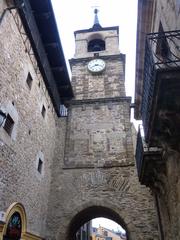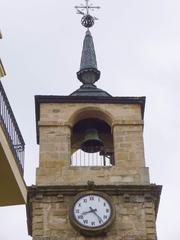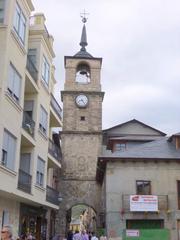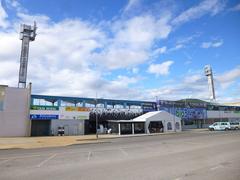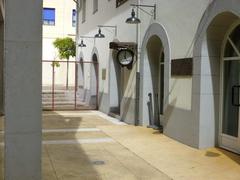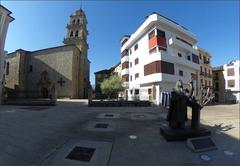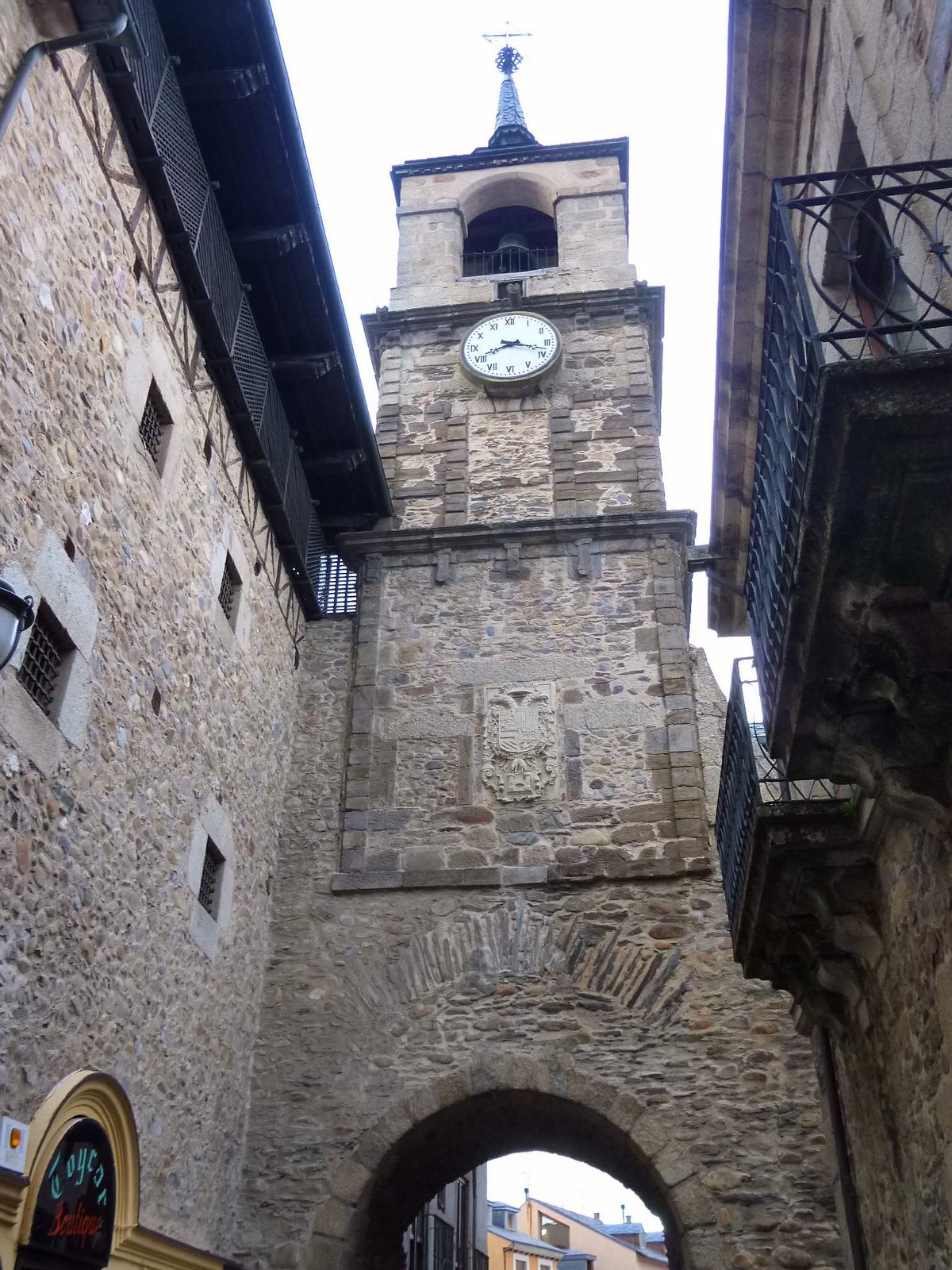
Torre del Reloj Ponferrada: Visiting Hours, Tickets, and Guide to Historical Sites
Date: 14/06/2025
Introduction: Why the Torre del Reloj Is a Must-Visit Historical Site
Ponferrada’s Torre del Reloj is more than an architectural landmark—it is a living symbol of the city’s evolution from a medieval stronghold to a vibrant modern hub. Rising above the last remaining city gate, the Arco de las Eras, this iconic clock tower not only anchors the historic quarter but also serves as a testament to the city’s resilience, civic pride, and layered history. For travelers exploring Castile and León, especially those following the Camino de Santiago, the Torre del Reloj offers a unique combination of historical significance, architectural beauty, and cultural vitality (castillodelostemplarios.com; Ayuntamiento de Ponferrada).
This guide provides essential details for planning your visit: historical context, architectural highlights, current visiting hours, ticketing, accessibility, travel tips, and information on nearby attractions. Whether you’re a history buff, a cultural explorer, or a pilgrim, the Torre del Reloj is an essential stop to understand and experience Ponferrada’s heritage.
Table of Contents
- Historical Overview
- Visitor Information
- Architectural Features
- Location, Urban Context, and Nearby Attractions
- Travel Tips and Visitor Services
- Integration with the Camino de Santiago
- Events and Local Culture
- Frequently Asked Questions (FAQ)
- Summary and Recommendations
- References
Historical Overview
Medieval Origins and Defensive Role
The Torre del Reloj stands atop the Arco de las Eras, the only surviving gate from Ponferrada’s city walls. This medieval arch was one of five original entrances, each strategically placed for defense and commerce. The semicircular stone arch is both an architectural relic and a symbolic threshold, separating the old town from newer urban developments (castillodelostemplarios.com).
Renaissance and Baroque Transformations
During the 16th and 17th centuries, the tower underwent significant changes. Master stonemasons introduced Renaissance elements, including balanced proportions and the royal coat of arms of King Philip II, carved by Juan de la Lastra. In 1693, the Baroque dome (chapitel), covered in slate, was added—a visual highlight that harmonizes with the towers of the nearby Town Hall (infobierzo.com; Itinerartis).
The Clock and Bell: Civic Life
The clock was installed in the early 19th century, while the bell chamber—crowned by the Baroque dome—has tolled the hours for centuries. The mechanism was modernized in 1920 with a donation from Minero Siderúrgica de Ponferrada, and again in 1972, with the original mechanism now displayed at the Museo del Bierzo (infobierzo.com).
Restoration and Preservation
Conservation efforts have been ongoing, with notable restorations in the 16th, 17th, and 20th centuries. The most recent major works occurred in 2000, ensuring the tower remains both structurally sound and accessible for future generations (infobierzo.com).
Visitor Information
Visiting Hours and Tickets
- Exterior Access: The archway beneath the tower is open 24/7 as part of the main pedestrian route into the historic quarter.
- Interior Access: The interior is typically accessible during special events, guided tours, or heritage days. Standard hours for such visits are Tuesday to Sunday, 10:00 AM–6:00 PM (closed Mondays and major holidays), but schedules may vary. Always verify on the official tourism website before your visit.
- Tickets: There is normally no fee for viewing or passing through the tower’s exterior. Guided tours or special interior visits may have a nominal charge (often around €3, with discounts for students and seniors; children under 12 may enter free).
Accessibility
- Exterior: The surrounding plaza and streets are pedestrian-friendly and accessible.
- Interior: Access involves narrow, uneven spiral staircases not suitable for visitors with reduced mobility. Assistance may be available on request; inquire in advance.
- Visitor Services: The nearby tourist office offers maps, brochures, and guidance in multiple languages (Ayuntamiento de Ponferrada).
Guided Tours and Events
- Guided Tours: Offered seasonally, often as part of broader walking tours of Ponferrada’s historic center. Contact the local tourist office for schedules and booking.
- Special Events: The tower is occasionally illuminated or opened for public viewing during festivals, notably during the Fiestas de la Encina in September (Winalist).
Architectural Features
Structure and Materials
- Foundation/Base: Built above the semicircular Arco de las Eras, the gateway’s medieval arch supports the tower and serves as a symbolic passage.
- Main Body: Rectangular in plan, the tower is constructed of local slate masonry and river stones, with granite used for corners and door jambs—an elegant Renaissance touch (Turismo Ponferrada).
- Vertical Sections:
- First Body: Displays the royal coat of arms of Philip II.
- Second Body: Houses the clock mechanism.
- Third Body: Contains the bell chamber and is capped by the Baroque dome.
Decorative Details
- Heraldic Shields: The stone escutcheon of Philip II signifies royal patronage and the city’s importance during the Renaissance (Turismo Castilla y León).
- Clock and Bells: The clock face and mechanism—updated in the 20th century—are local points of pride. The bell’s chimes mark daily life and special occasions (Cadena SER).
- Baroque Dome: The 1693 chapitel, built of wood and slate, crowns the tower and is visible from points across the city (Itinerartis).
Interior Experience
- Access: Entry is via a stone staircase on Calle Carnicerías.
- Levels: The ground floor was once a fish storage room; upper levels house the clock and bell.
- Viewpoint: The bell chamber offers panoramic views of Ponferrada’s historic core.
Location, Urban Context, and Nearby Attractions
The Torre del Reloj stands at the heart of Ponferrada’s old town, linking the Plaza del Ayuntamiento with Calle del Reloj (Turismo Ponferrada). Its strategic location makes it a natural starting point for exploring:
- Castillo de los Templarios: A five-minute walk to the city’s Templar fortress (Winalist).
- Basilica de la Encina: The city’s Renaissance-Baroque church and spiritual center.
- Museo del Bierzo: Regional museum featuring the original clock mechanism.
- Calle del Reloj: The primary pedestrian thoroughfare, lined with shops and traditional architecture.
Travel Tips and Visitor Services
- Best Time to Visit: Early morning or late afternoon provide the best lighting for photographs. The area is especially lively during local festivals.
- Amenities: Cafés, restaurants, and shops are plentiful on Calle del Reloj and nearby streets.
- Accessibility: The surrounding area is paved, but some old town streets are cobbled and uneven.
- Safety: Ponferrada is safe for visitors; general precautions apply (Winalist).
Integration with the Camino de Santiago
The Torre del Reloj is a significant stop for pilgrims traveling the Camino de Santiago. Marking the symbolic entrance to Ponferrada’s historic quarter, it is a meeting point and photo opportunity for travelers on this legendary route. Local businesses cater to pilgrims, offering supplies, souvenirs, and information (Winalist).
Events and Local Culture
Throughout the year, the Torre del Reloj serves as a backdrop for community events, processions, and concerts. During the Fiestas de la Encina, processions pass beneath the arch, and the tower is illuminated for dramatic effect. The site is deeply woven into Ponferrada’s civic identity and local traditions (Winalist).
Frequently Asked Questions (FAQ)
Q: What are the Torre del Reloj’s visiting hours?
A: The passage under the tower is always open. Interior access is available during guided tours or special events, generally Tuesday–Sunday, 10:00 AM–6:00 PM; always check the official tourism website for updates.
Q: Is there an entry fee?
A: No fee to admire the exterior or pass through the arch. Guided tours may have a small charge.
Q: Is the tower accessible for visitors with disabilities?
A: The plaza and surrounding streets are accessible; interior staircases are not suitable for those with mobility challenges.
Q: Are guided tours available?
A: Yes, especially during festivals and the tourist season. Inquire at the Ponferrada Tourist Office.
Q: What other attractions are nearby?
A: Castillo de los Templarios, Basilica de la Encina, Museo del Bierzo, and Calle del Reloj.
Summary and Recommendations
The Torre del Reloj encapsulates Ponferrada’s historical depth and civic spirit, bridging medieval and modern eras through its architecture and urban presence. As the sole surviving city gate, it is both a monument and a vibrant urban landmark. With no entry fee for exterior access, convenient central location, and proximity to major attractions, it is an essential highlight for any visit to Ponferrada (castillodelostemplarios.com; Itinerartis).
Visitor tips:
- Check official sources for the latest on opening times and interior visits.
- Plan to visit nearby sites for a full historical experience.
- Download the Audiala app for curated walking tours and up-to-date advice.
References
- Castillodelostemplarios.com – Torre del Reloj
- Infobierzo.com – Campanadas Interior Torre Reloj Ponferrada
- Itinerartis.com – 10 Surprising Things to Do in Ponferrada
- Ayuntamiento de Ponferrada – Torre del Reloj
- Turismo Ponferrada – Torre del Reloj
- Winalist.com – Ponferrada Things to Do Guide
- Turismo Castilla y León – Tower Clock
- Cadena SER – La Torre del Reloj de Ponferrada
Plan your visit, explore the heart of Ponferrada’s heritage, and let the Torre del Reloj guide your journey through history. For more travel insights, download the Audiala app and follow us on social media for the latest events and tips.
